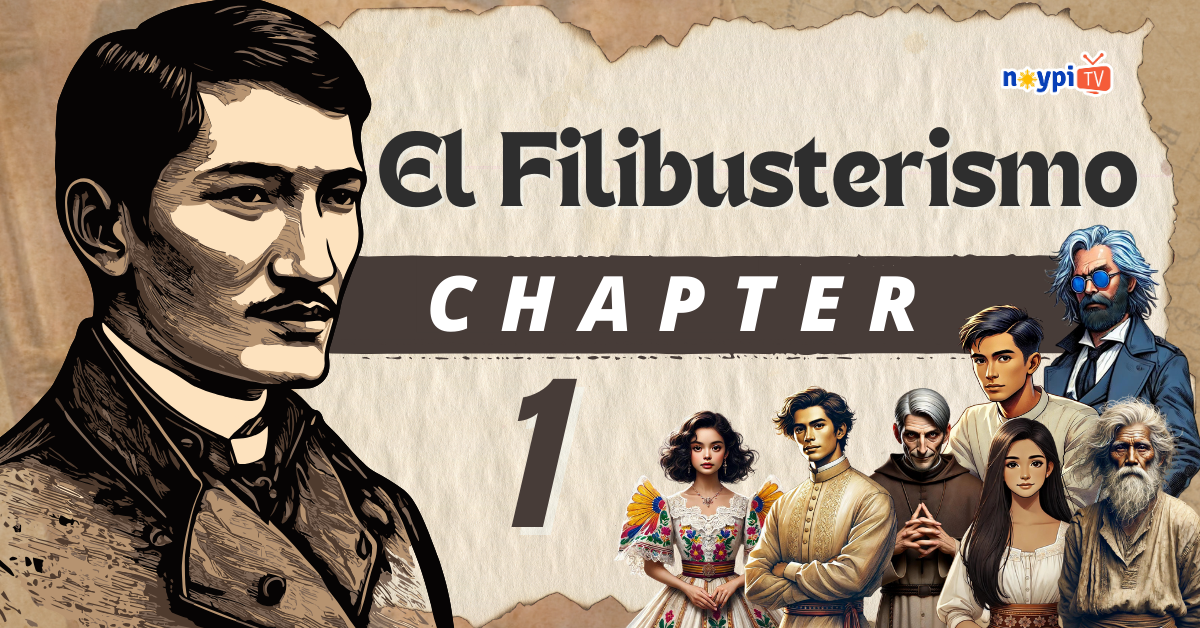In this article, we will discuss a brief summary of El Filibusterismo Chapter 1 – On the Upper Deck. Additionally, we will examine the key events, characters, setting, and the lessons, messages, or implications that can be taken from this chapter.
Related: El Filibusterismo Summary of the Entire Novel (Short Summary) »
Table of Contents
Summary of El Filibusterismo Chapter 1 – On the Upper Deck
One December morning, the steamship Tabo was navigating the winding path of the Pasig River toward Laguna. On the ship’s deck are a mix of locals, friars, and officials, divided by social hierarchy, with Europeanized passengers enjoying the upper deck while locals crowd the lower deck.
Among the upper-deck passengers are Doña Victorina, a pretentious Filipina obsessed with European standards; Don Custodio, a pompous bureaucrat; Simoun, a mysterious and influential jeweler; and various friars, including the sharp-tongued Padre Salvi and the Dominican Padre Sibyla.They were discussing plans to improve the Pasig River and projects of the Obras del Puerto.
Simoun suggested digging a straight and direct path from the start to the end of the Pasig River. The excavated soil would be used to block its former course. Simoun recommended using prisoners as laborers to save costs. If that wasn’t enough, the citizens could be forced to work without pay.
However, Don Custodio, a self-important official, disagreed with Simoun’s plan due to the potential for rebellion. Instead, he suggested compelling the residents near the Pasig River to raise ducks. The idea was that the ducks would eat snails, which would help deepen the river. Doña Victorina also opposed this idea, as she detested duck eggs.
See also: El Filibusterismo Summary of Each Chapter (1-39) »
Important Events
- The steamer Tabo struggles to navigate the Pasig River, with the captain and crew working hard to avoid sandbars and shallow waters.
- Doña Victorina, seated among the upper-deck passengers, complains about the slow progress and expresses her disdain for the local population.
- Simoun proposes a drastic plan to dig a new canal, suggesting the use of forced labor from the local population to complete the project.
- Don Custodio defends his own project of using ducks to naturally clear the riverbed, contrasting with Simoun’s harsh approach.
- The passengers engage in a heated debate about progress and labor, revealing their conflicting views on how to improve the country.
Important Characters in El Filibusterismo Chapter 1
These are the characters mentioned in the first chapter of El Filibusterismo:
Simoun
He is the returning Juan Crisostomo Ibarra from the novel Noli Me Tangere. In this chapter, he is a jeweler who proposed the radical solution of digging a straight path for the Pasig River. This major project would involve prisoners as laborers.
Doña Victorina
A Filipino woman pretending to be Spanish. In this chapter, she questioned Don Custodio’s idea of raising ducks near the Pasig River because she despised balut.
Don Custodio
One of the principales representing the Filipino populace. He opposed Simoun’s suggestion to dig a straight path in the Pasig River, fearing it could incite rebellion. Instead, he proposed raising ducks to deepen the river.
Ben Zayb
A journalist also present on the Tabo’s deck.
Padre Salvi, Padre Sibyla, Padre Camorra, and Padre Irene
Clergymen who were also part of the journey along the Pasig River.
Read more: El Filibusterismo Characters and Their Roles »
Setting in El Filibusterismo Chapter 1
The events take place on the steamer Tabo as it travels along the Pasig River. The upper deck, where the privileged passengers sit, is shaded and comfortable, while the lower deck is crowded with locals and cargo. The river itself is described as winding and difficult to navigate, with sandbars, bamboo groves, and small fishing structures along its banks.
Lessons in El Filibusterismo Chapter 1
- The governance of the Spaniards in the Philippines is compared to the slow-moving Tabo steamship. The slow progress is attributed to leaders focusing on self-interest and hindering Filipino education to keep them subservient.
- Discrimination is evident in the division of passengers on the Tabo. The wealthy and Spanish-blooded stayed comfortably above deck, while Filipinos and Chinese were crammed below deck, enduring heat, engine noise, and discomfort.
- The chapter also portrays the selfishness and ignorance of those in power. Simoun’s suggestion to force prisoners and citizens into labor shows disregard for the people’s welfare. Meanwhile, Don Custodio’s suggestion reflects ignorance of nature and the people’s needs. Their disagreement highlights their self-serving interests rather than prioritizing the nation’s well-being.
- The chapter’s message emphasizes the importance of having honest and compassionate leadership. Decision-making should not be blinded by self-interest but should consider the welfare of everyone, especially the poor and oppressed.
And that concludes our lesson on El Filibusterismo Chapter 1 Summary, Characters, Setting, and Lessons. Did you find this article helpful? If yes, please share it with your classmates and friends so they too can learn from the first chapter of this novel.
You can also share it on your social media accounts. Just click the share button on your screen. If you have more questions about the lesson, please leave a comment below.
Read next: El Filibusterismo Chapter 2 Summary, Characters, Lessons, etc. »
